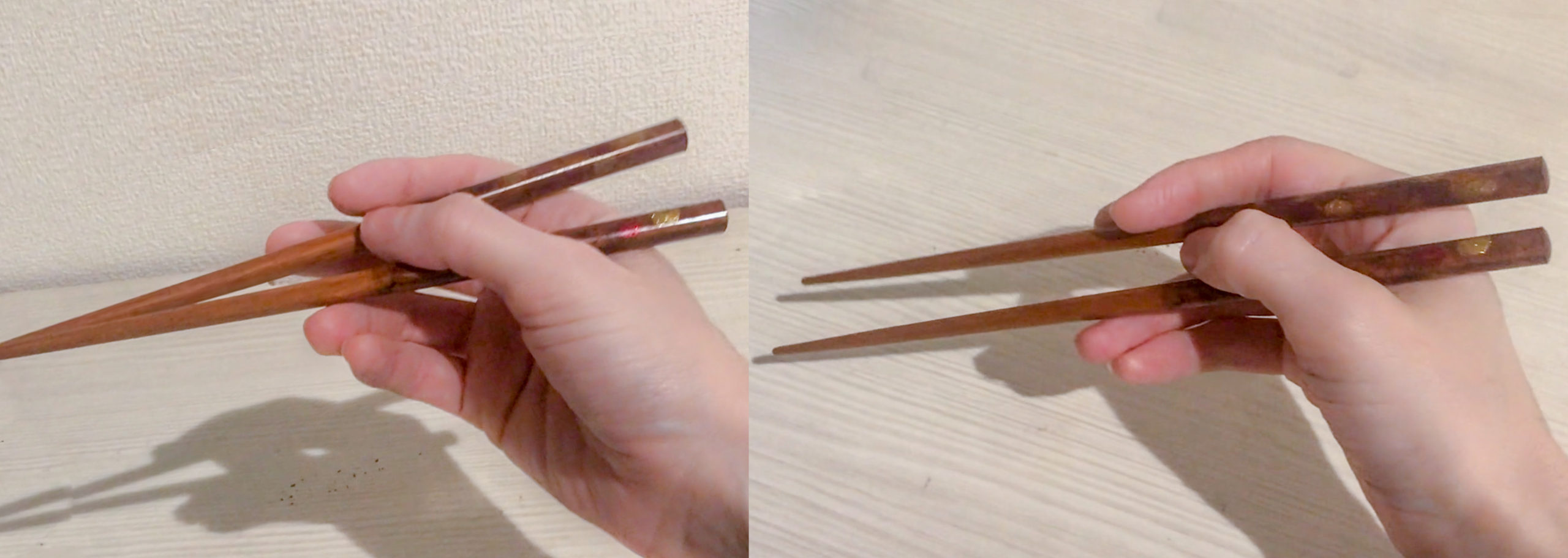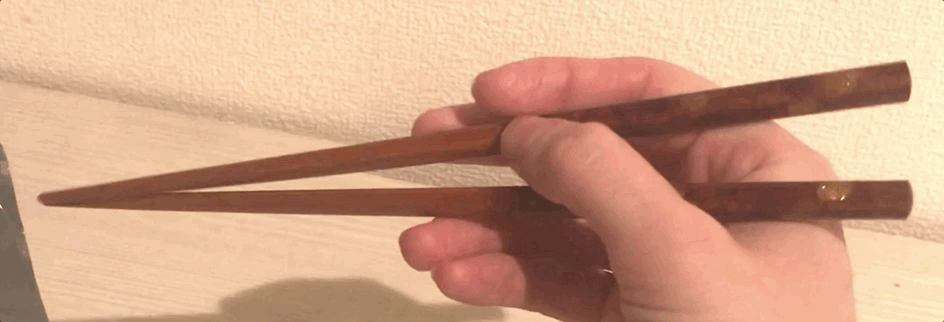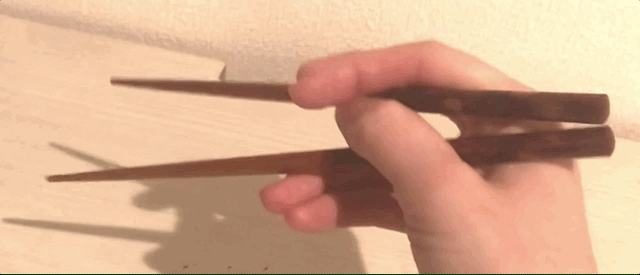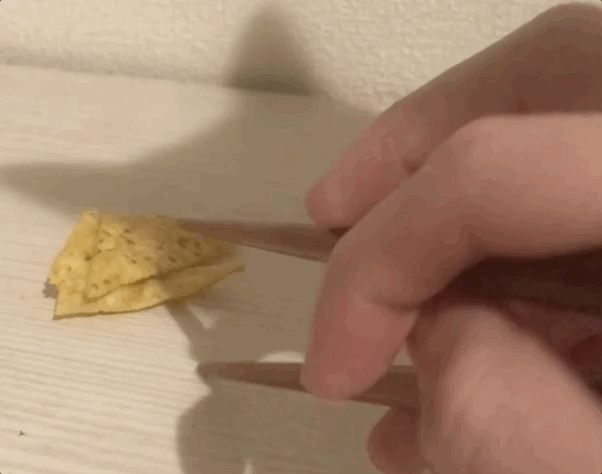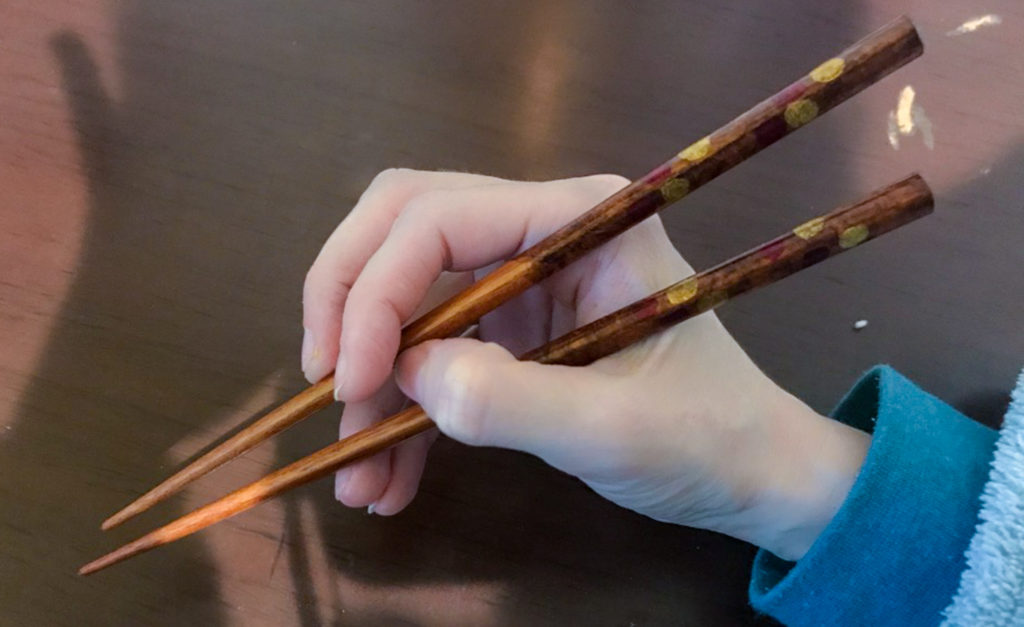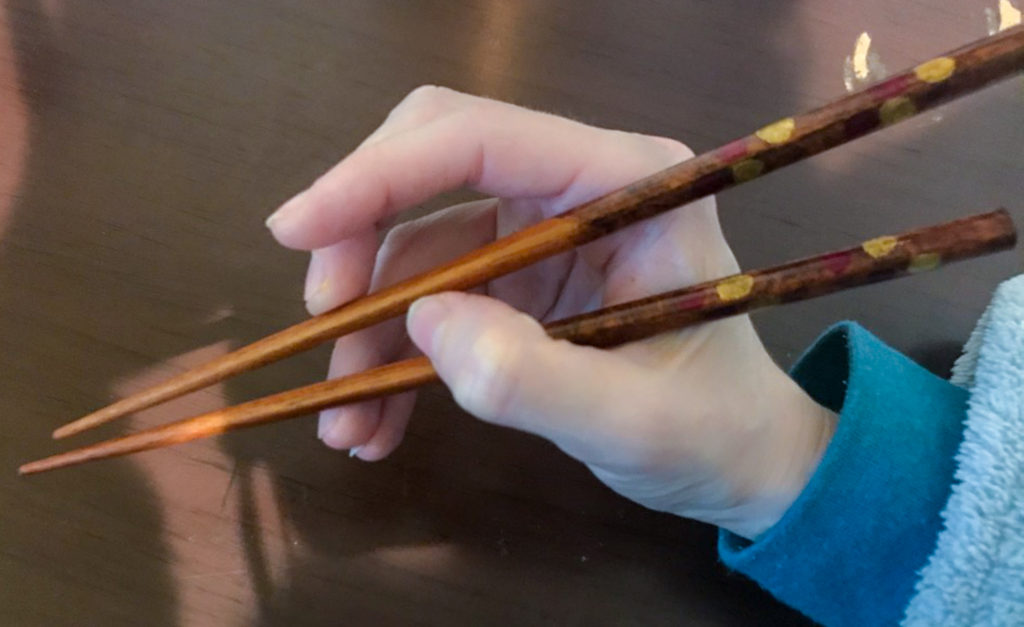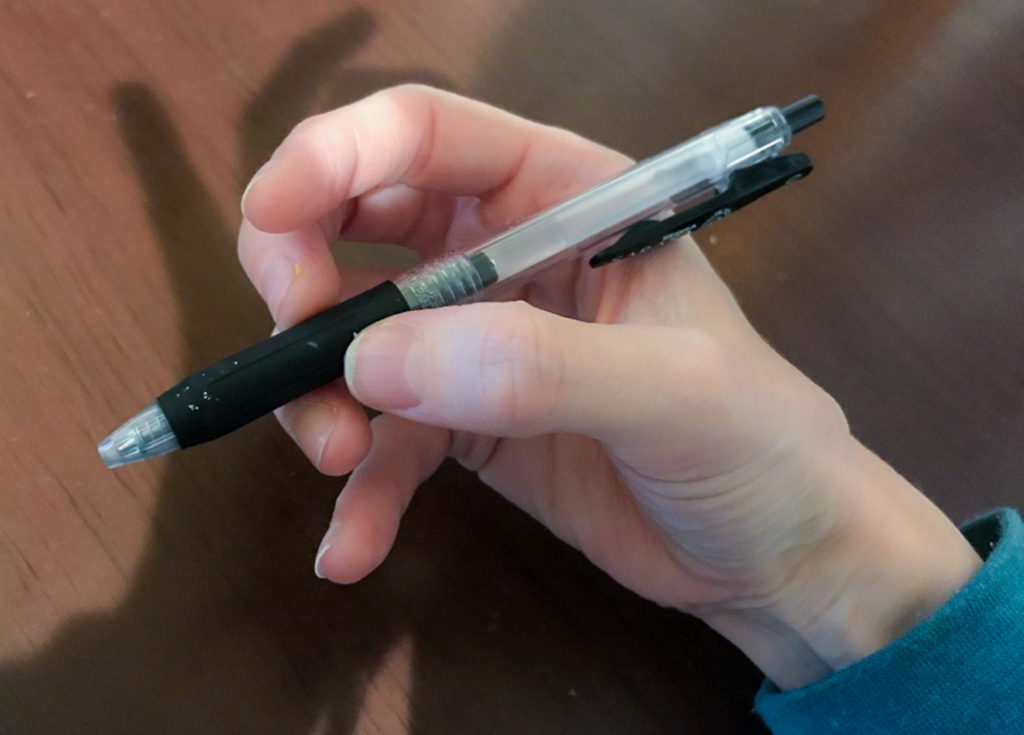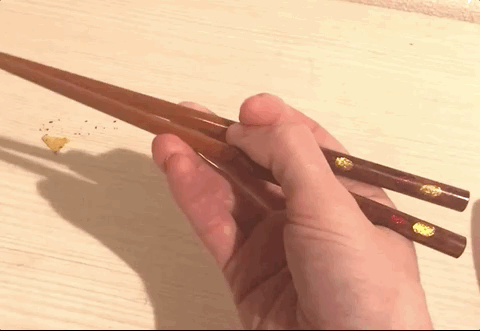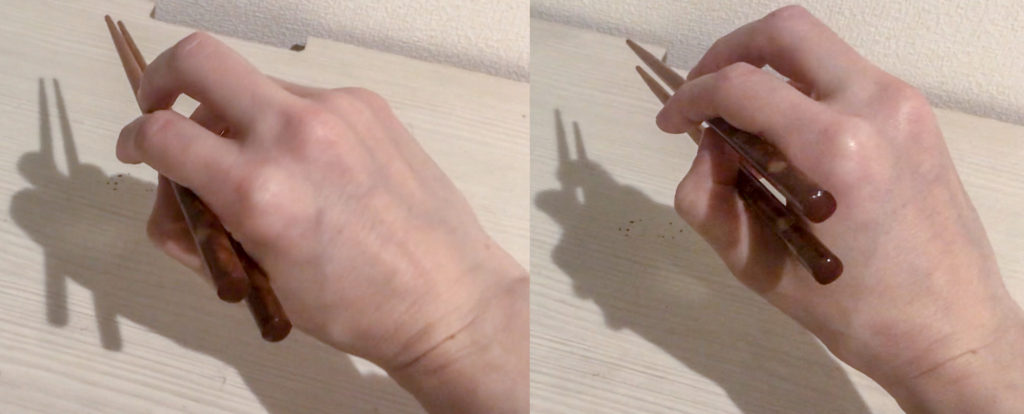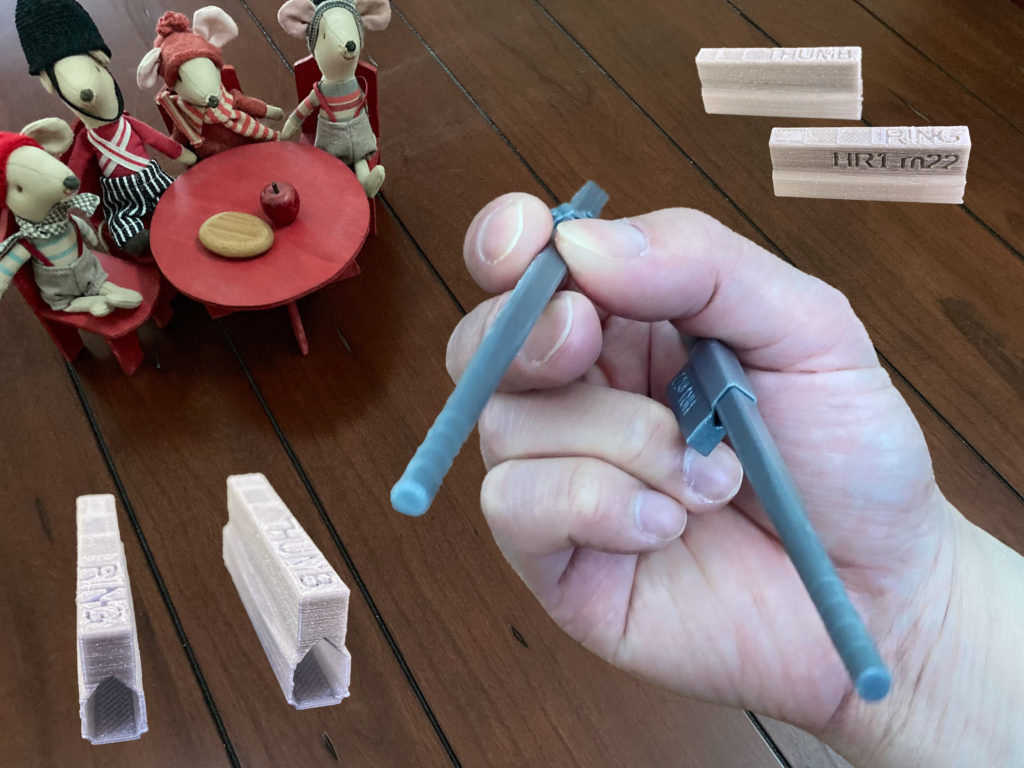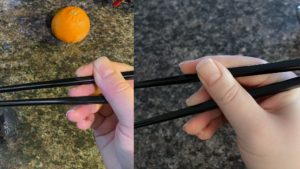Last Updated on 2022 年 01 月 30 日 by 編輯
The Count-to-4 grip is a variation of Standard Grip, where the tip segment of the thumb bends inward, instead of extending flat. This is a drastic departure from the Caswellian thumb required by the Standard Grip. A flat thumb in Standard Grip allows users of chopstick grips to push firmly down on both chopsticks, thus securing them in place throughout the alternating motion. A bent thumb in Count-to-4, on the other hand, forces a user to find a different way of holding the bottom chopstick, and of twirling the top chopstick.
This grip can be a useful alternative grip, for people who cannot wield the Caswellian thumb pose.
Table of Contents
Etymology
A great majority of the world count numbers with the hand by extending and folding fingers. Following illustration shows a hand counting numbers from 1 to 4.

Why is this alternative grip is called “Count-to-4”? The answer is evident when the closed posture of this grip is shown next to a hand counting to 4. The thumb is curled in, while the rest four fingers are extended almost straight. See more related alternative grips on the family tree.
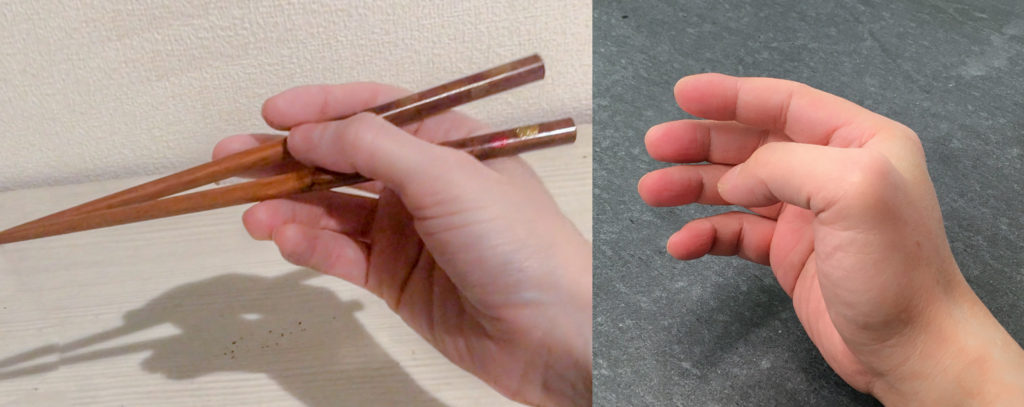
Count-to-4 vs. Standard Grip
At a glance, Count-to-4 (below left) looks drastically different from Standard Grip (below right). One reason is the bent tip segment of the thumb discussed earlier. A bent thumb cannot securely hold the bottom chopstick against other fingers using the 1-on-2-support technique, as explained in Learn to Use Chopsticks. This will be further explored in later sections. For now, it suffices to say that a Count-to-4 user must use the side of the thumb knuckle to hold the bottom chopstick down (below left), instead of the inside flesh of the thumb base (below right).
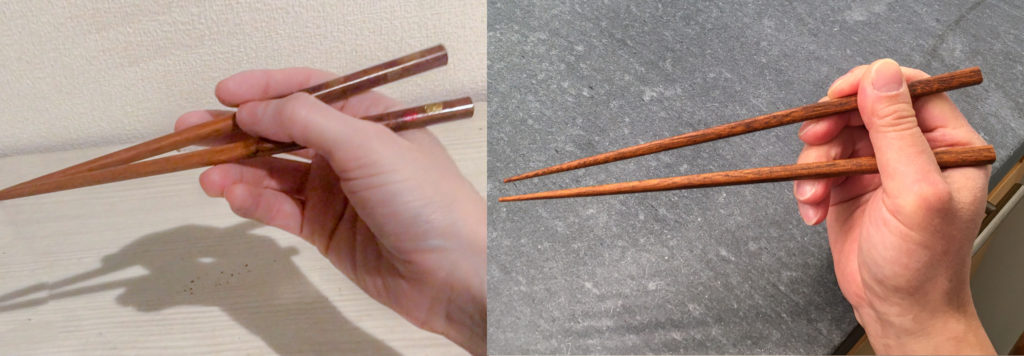
This small change in holding the bottom chopstick comes with grave ramifications for how the top chopstick is manipulated. In order to use the side of the thumb knuckle to push down on the stick, the thumb must be titled toward the tip of the chopstick (above left). The rest four fingers follow the thumb, and are extended straight outward as well. This is a striking visual departure from how they are curled inward in Standard Grip (above right). In this departure, Count-to-4 is similar to Vulcan Grip, the significance of which will be discussed later in this article, and further in a the article Count-to-kehkuh. For those of us not well-versed in Vulcan, “kehkuh” is how one says the number 4 in Vulcan.
With Count-to-4, the index finger is only an ornamental accessary. It plays almost no role in the alternating motion. The abandonment of the index finger in Count-to-4 is absolute, unlike the occasional disuse of the index finger in Dino Claws. In the two pictures shown below, the index finger is casually draped over the stick and the thumbnail, serving no function in actual operations of chopsticks.
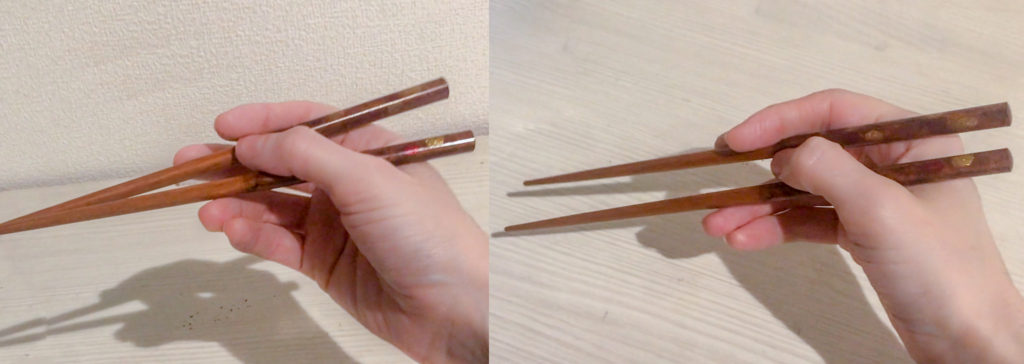
The manipulation of the top chopstick is left to the thumb and the middle finger alone. In the closed posture (above left), the top chopstick is held between the pulp of the middle finger and the pulp of the thumb. The tripod hold required by Standard Grip does not apply to Count-to-4. A “bipod hold” is used instead.
Surprisingly, the planetary gear train is still in play in Count-to-4. The thumb and the middle finger still “twirl” the stick, from the closed posture (above left) to the open posture (above right). In the open posture, the top chopstick has almost rolled out of the reach of the thumb, with the thumbnail now pushing the stick against the middle finger to hold it in place.
The open posture (below left) of Count-to-4 is limited in its maximum extension angle. This is due to the fact that all fingers are extended straight throughout the alternating motion. This is again similar to Vulcan Grip which suffers from the same limited range, as a result of the same extended fingers. On the other hand, Standard Grip uses the “air quote” gesture, curling and extending index and middle fingers with a far greater range (below right).
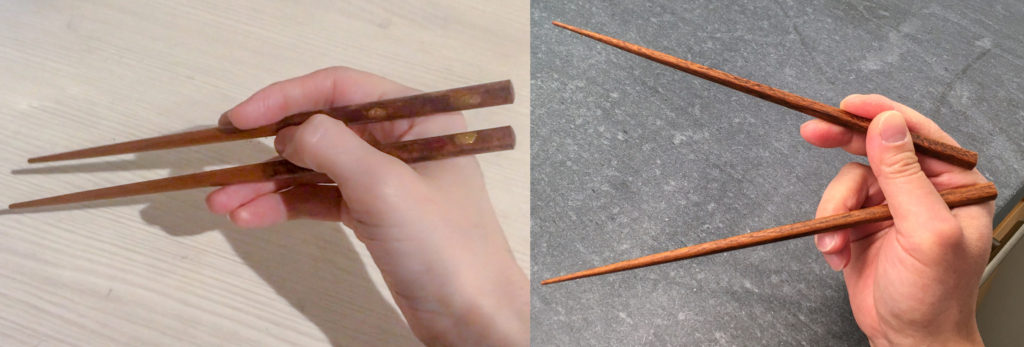
Alternating motion and sideway swing
Following slow-motion video demonstrates the planetary gear-like alternating motion of the top chopstick. The thumb and the middle finger roll the top chopstick in a “bipod” configuration, as they twirl it to extend tips apart.
When a user of Count-to-4 needs to extend tips of chopsticks far apart, the thumb pushes the top chopstick outward. This small sideway push by the thumb is amplified by leverage, thus extending tips wider than achievable via only twirling. This sideway effect is not drastic enough, nor frequently called for. So we do not classify Count-to-4 as a Sideway Swing variant.
Flattened middle finger during compression
Observe both slow-motion videos shown below. Pay attention to the shape of the middle finger, before and after tips of chopsticks clamp down on chips. Before the chip pick-up, the middle finger is slightly curved, with the distal knuckle bent. As the tips clamp down on chips, the distal knuckle extends flat, and the pulp of the middle finger squeezes down on the top chopstick, in order to generate enough compression force to hold chips.
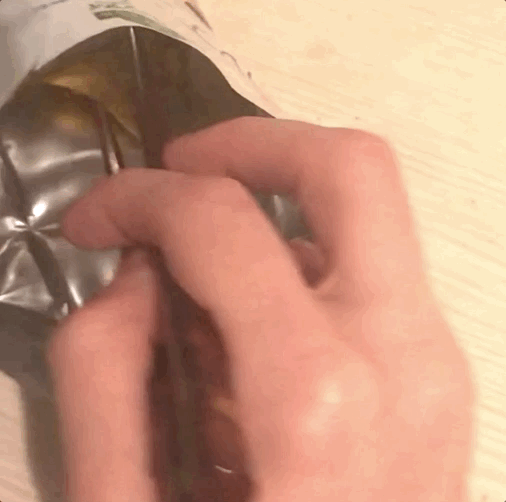
Unlike Standard Grip, the Count-to-4 grip cannot generate enough compression force via planetary gear train alone, because it doesn’t have the firm grip generated by three fingers with the tripod hold. Count-to-4 cannot count on the index finger for assistance. The index finger is helplessly draped over the thumbnail in the above video to the left. The index finger is similarly left in a carefree slumber on the top chopstick, in above video to the right.
Abandoned index finger
The picture below illustrate Count-to-4 grip as seen from the side. The distal knuckle of the thumb is bent at a steep angle. As discussed earlier, this forces the side of the thumb to be used, to hold the bottom chopstick in place. With this tilted thumb posture, the top chopstick is not supported by the traditional tripod hold. It is supported from the bottom by the tip of the thumb, and from the top by the middle finger. The index finger is left without a job. It drapes uselessly over the stick and the thumbnail.
The index finger may be lifted off the top chopstick and the thumb, with no effect on the operation of chopsticks. This is shown in the picture below. With the index finger lifted, the bipod hold on the top chopstick by the thumb and the middle finger is now visible without obstructions.
At marcosticks.org, we have long suspected a link between pen holding and alternative chopstick grips. We have pictures and videos of user writing with pens and eating with chopsticks, using basically the same finger postures and movements. We also have videos of users wielding forks and spoons using similar postures. You will find more information at: Hold Chopsticks like a Pen.
We’ll share just one pen-holding picture here. It shows the previous Count-to-4 user holding a pen, with an identical bipod hold. The index finger is similarly abandoned.
Count-to-4 vs. Vulcan Grip
The open posture of Count-to-4 (below left) looks very similar to that of Vulcan Grip (below right). Both feature the Vulcan salute from Star Trek. But there are two key differences between them. First, the thumb bends severely inward in Count-to-4, while in Vulcan salute, the thumb remains straight as is also the case in Standard Grip. As a result, Count-to-4 supports the top chopstick from the bottom, while Vulcan Grip does it from the side.

Secondly, Count-to-4 uses the side of the distal knuckle of the ring finger to support the bottom chopstick. Vulcan Grip does this using the pulp of the ring finger instead. In this regard, Count-to-4 remains true to Standard Grip.
Sometimes, however, we find grips that appear to straddle Count-to-4 and Vulcan Grip. The picture below to the right shows a Vulcan Grip where the thumb is slightly bent. Where Vulcan Grip stops and Count-to-4 begins is not easy to define. See the follow-up article Count-to-kehkuh, where we in fact describe a “Vulcan Count-to-4” grip, a cross between these two grips.

IP joint vs. MP joint
In this section we briefly talk about the Interphalangeal joint (IP joint) and the Metacarpophalangeal joint (MP joint). These two joints play a role in some user’s struggle to learn to twirl chopsticks. This is only an abridged discussion. The Caswellian thumb article is dedicated to this topic, and discusses inborn differences in anatomy in depth.
We suspect that some users have hereditary conditions that prevent them from adopting the Standard Grip. Either they are anatomically unable to do so, or they feel uncomfortable with its posture and finger movements. Some of these users end up adapting alternative grips such as Count-to-4.
Figure 4A below illustrates one thumb pose that people are able to perform instinctively. It is the thumbs-up gesture. The thumb points upward, with its two segments straightened to align with the back of the hand. That is, both the MP joint and the IP joint are “extended” outward. Figure 4B illustrates another easy pose for most people. It is the closed-fist gesture. The thumb is curled, with its two segments bent inward. That is, both the MP joint and the IP joint are “flexed”.
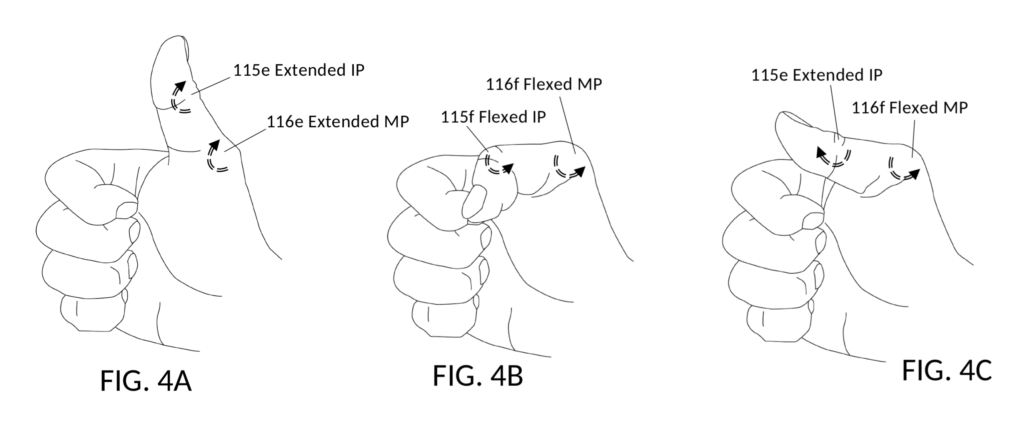
Unfortunately for the first-time chopstick learner user, what is needed for the Standard Grip is the unnatural thumb pose shown in figure 4C above. This pose requires that a learner bend the base segment of the thumb, while extending the tip segment. That is, the MP joint flexes inward, while the IP joint extends outward. We call this pose the Caswellian thumb pose.
Coping with anatomical constraints
So the unnatural Caswellian thumb pose shown in figure 4C above is what Standard Grip requires. The role of the thumb is shown visually in the two pictures found below, in figure 5W and 5C. They correspond to the wide-open posture and the closed posture, respectively.

Some people find it difficult to make this thumb pose as shown above. Some people are able to force the thumb into this pose temporarily, but cannot hold this pose for long. Some people find creative ways to cope with their inborn anatomically constraints, such as adapting the Count-to-4 grip described here. Following are additional video and pictures illustrating the Count-to-4 grip from various angles.

Training marcosticks
We have created training marcosticks to help beginners learn to use the Standard Grip. We have also created a finger helper device which specifically addresses users with anatomical issues described above. The latest aid are model B chopstick buddies. You can print them yourself, if you have a 3D printer at home.
There is also our model H finger helper, which is attached to the model T training marcosticks. You can also print these yourself.
Learn new grips
Some users of Count-to-4 grip can actually learn to adopt the unnatural thumb pose required for Standard Grip. Perhaps they are stuck for now with Count-to-4, only because they happened to have learned as a kid to write with pens using the same bipod posture. For these users, Standard Grip is within reach. They simply need to practice the Caswellian thumb pose, before they can become comfortable with the 1-on-2-support and the tripod hold, as taught in Learn to Use Chopsticks.
Other users may not be so lucky. Some users of Count-to-4 will never be able to wield Standard Grip with a flattened thumb. Perhaps hereditary conditions constraint their muscle movements. For these users, we have issued patents and pending patent applications on training chopsticks and chopstick tools that will allow these users to wield the Standard Grip with dexterity, range and power, without having to flatten their thumb tip segment. 3D models of these enhanced chopsticks are made available for all to print for free. Check out model B Chopstick Buddies and model H Finger Helpers.
Taiwanese: 比到四
This grip is known as 比到四 (pi kàu sù) in Taiwanese.
* pictures and videos: courtesy of u/sudakifiss.
